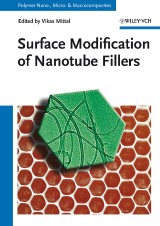Details

Surface Modification of Nanotube Fillers
Polymer Nano-, Micro- and Macrocomposites 1. Aufl.
|
CHF 142.00 |
|
| Verlag: | Wiley-VCH |
| Format: | |
| Veröffentl.: | 10.02.2011 |
| ISBN/EAN: | 9783527635108 |
| Sprache: | englisch |
| Anzahl Seiten: | 331 |
DRM-geschütztes eBook, Sie benötigen z.B. Adobe Digital Editions und eine Adobe ID zum Lesen.
Beschreibungen
The book series "Polymer Nano-, Micro- and Macrocomposites" provides complete and comprehensive information on all important aspects of polymer composite research and development, including, but not limited to, synthesis, filler modification, modeling, characterization as well as application and commercialization issues. Each book focuses on a particular topic and gives a balanced in-depth overview of the respective subfield of polymer composite science and its relation to industrial applications. With the books the readers obtain dedicated resources with infomation relevant to their research, thereby helping to save time and money.<br> In this first volume in the series, authors from leading academic institutions and companies share their first-hand knowledge of nanotube-surface enhancements for use in polymer composites. All the important methods for the functionalization of nanotube fillers, including polymer wrapping, non-covalent modification with nanoparticles, silica layers or entrapped micelles, chemically induced growth of multilayers, techniques based on covalent bonding, such as polmer or quantum dot attachment, and direct polymerization approaches are covered.<br>
Preface<br> CARBON NANOTUBES SURFACE MODIFICATIONS: AN OVERVIEW<br> Introduction<br> Noncovalent Functionalization of Nanotubes<br> Covalent Modification of Carbon Nanotubes<br> MODIFICATION OF CARBON NANOTUBES BY LAYER-BY-LAYER ASSEMBLY APPROACH<br> Introduction<br> Layer-by-Layer Modification of the Carbon Nanotubes<br> LbL Assembly on CNTs Using Click Chemistry<br> LbL Assembly on Vertically Aligned (VA) MWNTs<br> LbL on CNTs of Biological Molecules<br> LbL on CNTs for Template Development<br> Applications of LbL-Modified CNTs<br> Conclusions<br> NONCOVALENT FUNCTIONALIZATION OF ELECTRICALLY CONDUCTIVE NANOTUBES BY MULTIPLE IONIC OR PI-PI STACKING INTERACTIONS WITH BLOCK COPOLYMERS<br> Noncovalent Functionalization of CNTs by Pi-Pi Stacking with Block Copolymers Bearing Pyrene Groups<br> Noncovalent Functionalization of Electrically Conducting Nanotubes by Multiple Ionic Interactions with Double-Hydrophilic Block Copolymers<br> MODIFICATIONS OF NANOTUBES WITH CONJUGATED BLOCK COPOLYMERS<br> Introduction<br> Synthesis of P3HT Block Copolymer<br> Dispersion of CNTs<br> Conclusions and Perspective<br> THEORETICAL ANALYSIS OF NANOTUBE FUNCTIONALIZATION AND POLYMER GRAFTING<br> Introduction<br> Theoretical Techniques in Modeling Nanotube Functionalization<br> Functionalizing Carbon Nanotubes through Mechanical Deformation<br> Functionalizing Carbon Nanotubes via Chemical Modification<br> Polymer Grafting<br> Summary<br> COVALENT BINDING OF NANOPARTICLES ON CARBON NANOTUBES<br> Introduction<br> Covalent Binding of Quantum Dots on CNTs<br> Covalent Binding of Magnetic Nanoparticles on CNTs<br> Covalent Binding of Gold Nanoparticles on CNTs<br> Growth of Poly(amidoamine) Dendrimers on Carbon Nanotubes<br> Application of Nanoparticles-Conjugated CNTs Composites<br> Concluding Remarks<br> AMINE-FUNCTIONALIZED CARBON NANOTUBES<br> Introduction<br> Functionalization Strategies for CNTs<br> Importance of Amine Functionalization<br> Methods of Amine Functionalization<br> Characterization Techniques<br> Degree of Amine Functionalization<br> Changes in the Band Structure<br> Applications of Amine-Functionalized CNTs<br> Limitations of Amine-Functionalized CNTs<br> Conclusions<br> FUNCTIONALIZATION OF NANOTUBES BY RING-OPENING AND ANIONIC SURFACE INITIATED POLYMERIZATION<br> Introduction<br> Surface-Initiated Polymerization<br> Conclusions<br> GRAFTING OF POLYMERS ON NANOTUBES BY ATOM TRANSFER RADICAL POLYMERIZATION<br> Introduction<br> Grafting of Polymers on CNTs by ATRP<br> Functionalization of CNTs by Other CRPs<br> Grafting of Polymers on Other Nanotubes by ATRP<br> Conclusions<br> POLYMER GRAFTING ONTO CARBON NANOTUBES VIA CATIONIC RING-OPENING POLYMERIZATION<br> Introduction<br> Cationic Ring-Opening Polymerization of Cyclic Monomers in the Presence of Chain Transfer Reagents in One Pot<br> Preparation of Polymers-Grafted Carbon Nanotubes<br> Applications of Polymer-Grafted CNTs<br> PLASMA DEPOSITION OF POLYMER FILM ON NANOTUBES<br> Introduction<br> Principle and Experiment<br> Results<br> Summary<br> FUNCTIONALIZATION OF CARBON NANOTUBES BY POLYMERS USING GRAFTING TO METHODS<br> Introduction<br> Overview of the "Grafting to" Methods<br> Conclusions<br> ORGANIC FUNCTIONALIZATION OF NANOTUBES BY DIPOLAR CYCLOADDITION<br> Introduction<br> The Case of Azomethine Ylide<br> The Case of Pyridinium Ylides<br> The Case of Nitrile Oxide<br> The Case of Nitrone<br> The Case of Nitrile Imines<br> Conclusions
"The book should be of daily use for chemists and materials scientists working in the field of polymeric research and should serve as a practical guide for finding the smartest way of mechanical or functional property improvement of a given polymer . . . And, very likely, one day a separate book devoted to their surface functionalizations toward applications in diverse composites, at the same level of excellence in detail and specification, as the regarded one, edited by Vikas Mittal, will emerge." (Materials Views, 27 July 2011) <p> </p>
Vikas Mittal is Polymer Engineer at BASF Polymer Research in Ludwigshafen, Germany. He obtained his PhD in 2006 in Polymer and Materials Engineering from the Swiss Federal Institute of Technology in Zurich, Switzerland. Later, he worked as a Materials Scientist in the Active and Intelligent Coatings section of SunChemical in London, UK. His research interests include polymer nanocomposites, novel filler surface modifications, thermal stability enhancements, polymer latexes with functionalized surfaces etc. He has authored over 40 scientific publications, book chapters and patents on these subjects.
The book series "Polymer Nano-, Micro- and Macrocomposites" provides complete and comprehensive information on all important aspects of polymer composite research and development, including, but not limited to, synthesis, filler modification, modeling, characterization as well as application and commercialization issues. Each book focuses on a particular topic and gives a balanced in-depth overview of the respective subfield of polymer composite science and its relation to industrial applications. With the books the readers obtain dedicated resources with infomation relevant to their research, thereby helping to save time and money.<br> In this first volume in the series, authors from leading academic institutions and companies share their first-hand knowledge of nanotube-surface enhancements for use in polymer composites. All the important methods for the functionalization of nanotube fillers, including polymer wrapping, non-covalent modification with nanoparticles, silica layers or entrapped micelles, chemically induced growth of multilayers, techniques based on covalent bonding, such as polmer or quantum dot attachment, and direct polymerization approaches are covered.<br>
Diese Produkte könnten Sie auch interessieren:

The History, Use, Disposition and Environmental Fate of Agent Orange

von: Alvin Lee Young

CHF 118.00















